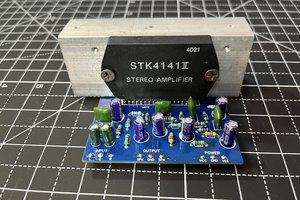I had this idea after being up for 36 hours a few years ago, as a kind of meeting place between Braitenburg Vehicles, Analog Sequencers, the Atari Punk Console, and Lego. The basic concept is that parameters on an analog synth are controller by variable resistors usually, but those could be some other kind of resistor, like LDRs. An LDR in a short tube will have an "interesting" voltage profile as it passes by a light source. Putting the whole thing on a rotating platform adds 'rhythm', and different sized gears adds complexity/interest (if you are interested in droney electronic music, which I am).
Gears will be in the style of Mathias Wandel's woodgears.ca gears, with a 4-pole TRRS plug pushfitted in the centre. The plug carries power to the gear, and also audio back from the gear. The plugboard is a grid of 4-pole sockets with a simple audio mixer in the back to produce the final audio output. Gears have a series of dowel holes around the edge to mount sensors or emitters, and a central mount for a small PCB. The PCB is powered by the TRRS power, and contains either a synth module (simple 555/logic gate stuff, most likely), and/or sockets to connect emitters and detectors to from the edge of the gear.
I'd like to find a stash of those old telephone exchange TRRS plugs (e.g. GPO plugs in the UK) if I can, rather than the wimpy TRRS plugs that mobile phones use. Clunky is better.
Goals
0 - Complex behaviour from simple rules.
1 - No magic. It should be very obvious from looking at it what is going on (apart from the actual synth circuits, I guess)
2 - Usable. It should be possible to produce a definite variety of sound - perhaps this will need a triggered sample player? I feel that is cheating though.
3 - Using other forces (magnetism, gravity) is definitely allowed. Also strobes for effect at a distance, or perhaps filters to select what is affected.
4 - Tactile. Hand cranked, clattery, chunky and pleasant to handle parts.

 Howard Jones
Howard Jones




 lion mclionhead
lion mclionhead
 Sagar 001
Sagar 001
 Lithium ION
Lithium ION
 Greg Does Things
Greg Does Things
If the gears replicate the relative orbital periods of the planets, maybe you will be able to achieve the "music of the spheres" :-)